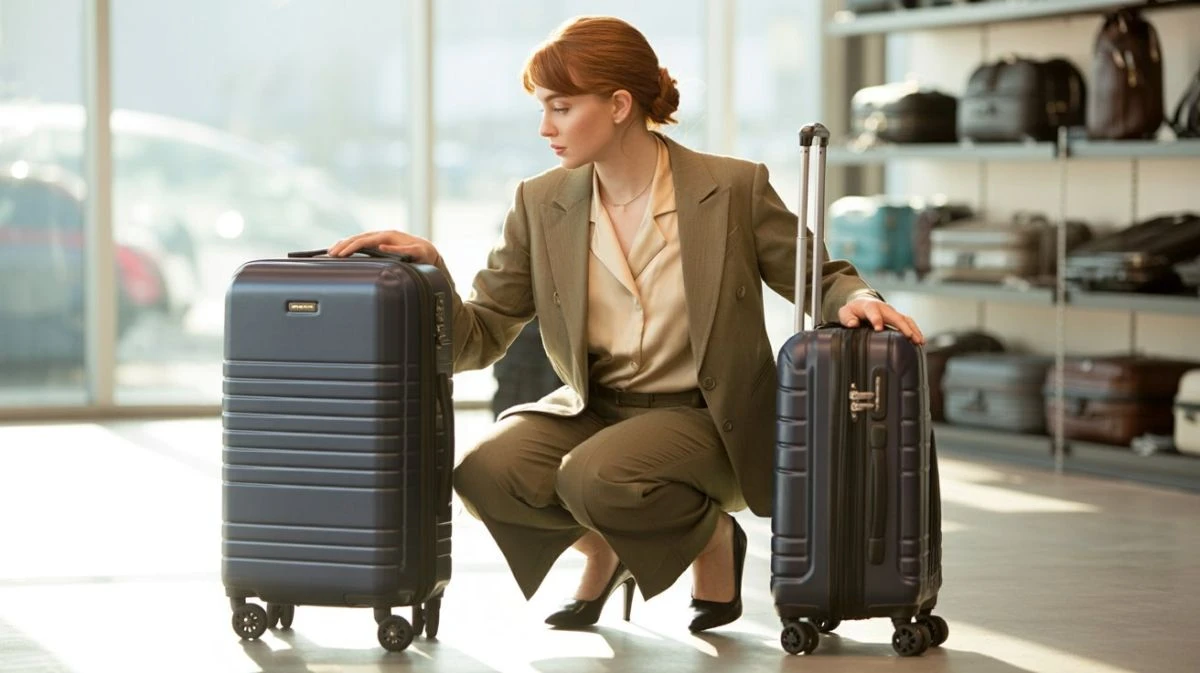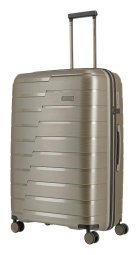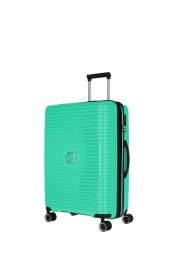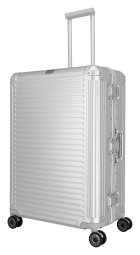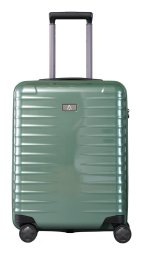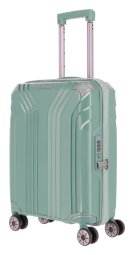Hello travelers! Choosing a new travel suitcase can be exciting, but also a bit of a challenge. If you want your travel companion – your new suitcase – to serve you long and reliably, it's crucial to focus on the material. The material determines the suitcase's durability, weight, and even what type of travel it's best suited for. In this comprehensive guide, we'll dive into the world of travel suitcase materials, uncover their secrets, and summarize their pros and cons.
Contents:
- Hardshell: A Detailed Look at Hardshell Suitcase Materials
- Textile Elegance and Practicality: Softshell Suitcase Materials
- Hybrid Suitcases: The Best of Both Worlds?
- Which Suitcase to Choose? Factors for Selecting the Best Travel Suitcase Material
- Suitcase Care by Material: How to Extend Its Lifespan
- Frequently Asked Questions
- Your Ideal Suitcase Awaits!
Hardshell: A Detailed Look at Hardshell Suitcase Materials
Hardshell suitcases are made from various types of plastics or metals, each with unique properties affecting the suitcase's durability, weight, and price. Let's look at the most common suitcase materials.
ABS Plastic
ABS plastic (Acrylonitrile Butadiene Styrene) is one of the most widespread and most affordable materials for making travel suitcases. It is a relatively strong and rigid plastic that provides good basic protection for the contents.
- Pros: The main advantage is the low purchase price. ABS suitcases are also relatively lightweight and offer decent impact resistance for normal use. The surface can be glossy or textured, which helps to hide minor scratches.
- Cons: Compared to more advanced materials like polycarbonate, ABS is less flexible. This means that it can be more prone to cracking under very strong impact or in low temperatures (in the cold). It is also usually slightly heavier than suitcases made from polycarbonate.
Who is it ideal for: ABS plastic suitcases are a great choice for occasional travelers looking for an affordable suitcase for a holiday once or twice a year, who don't need the highest possible durability.
Polycarbonate
Polycarbonate (PC) is considered a premium material in the world of hardshell suitcases. It is known for its extraordinary durability and flexibility. This durable material is also used to make bulletproof glass and mobile phone cases, which attests to its toughness. Polycarbonate travel suitcases are very popular.
- Pros: Polycarbonate suitcases excel in high impact resistance – the flexible polycarbonate material can absorb the energy of an impact without cracking. They are also very lightweight, which is key for air travel where every kilogram counts. They offer a modern look and a long lifespan. A polycarbonate suitcase is often seen as the best choice.
- Cons: The main disadvantage is the higher price compared to ABS or polypropylene. The smooth polycarbonate surface can also be more prone to visible scratches, which is why many manufacturers opt for a textured surface that masks scratches better.
Who is it ideal for: Polycarbonate luggage is perfect for frequent travelers, especially those who fly. If you are looking for a combination of low weight, high durability, and modern design, and are willing to pay a bit more, investing in polycarbonate luggage is the right choice.
Polypropylene
Polypropylene (PP) is another very popular material for making hardshell travel suitcases, offering a great compromise between durability, weight, and price. It is a very tough and flexible plastic. Polypropylene suitcases are known for their strength.
- Pros: A polypropylene suitcase is exceptionally resistant to cracking. It is also relatively lightweight, although typically a bit heavier than polycarbonate suitcases. A big advantage compared to polycarbonate is its affordability, which is often lower, while still offering a high level of protection.
- Cons: Some older or cheaper types of polypropylene may have been less durable in extreme temperatures, but modern PP alloys have largely eliminated this problem. It may not look as premium as polycarbonate.
Who is it ideal for: PP suitcases are an excellent choice for travelers looking for maximum durability at a reasonable price. They are great for family holidays and more frequent travel, where the suitcase is subjected to rougher handling.
Aluminum
Aluminum suitcases represent the pinnacle in the category of durable and luxurious luggage. They are known for their iconic design and robust construction. Aluminum as a material is very specific.
- Pros: Aluminum offers extreme resistance to mechanical damage and excellently protects the contents of the suitcase. It has a characteristic, often premium to industrial look, which for many travelers is a symbol of high social status. Aluminum suitcases are also very resistant to moisture and extreme temperatures.
- Cons: The main disadvantage is the high price and also the higher weight compared to plastic alternatives. Although aluminum is very strong, it is prone to dents and scratches. However, many owners see these "travel scars" as a patina and proof of adventure. Aluminum is not flexible, so it does not absorb impacts by deforming like polycarbonate. Its resistance to cracking, however, is high.
Who are they for: For demanding travelers who prioritize maximum protection, iconic design, and are willing to invest a higher amount. Ideal for those who often transport valuable or fragile items and don't mind the higher weight of the suitcase.
ABS + Polycarbonate
Travel suitcase manufacturers often resort to a combination of ABS and polycarbonate to leverage the advantages of both materials and offer a suitcase with balanced properties.
How it works: Typically, polycarbonate is used as the outer layer of the suitcase due to its higher scratch resistance and flexibility, which better absorbs impacts. A thinner layer of polycarbonate also gives the suitcase a more attractive, often glossier, look. The inner layer or core of the suitcase is then made of ABS plastic, which ensures the strength of the construction and helps to keep the production costs, and thus the final price of the suitcase, at an acceptable level.
- Pros: The main advantage is better durability and flexibility than a pure ABS suitcase. Suitcases made from this blend are generally more resistant to cracking and handle impacts better. At the same time, they are more affordable than 100% polycarbonate suitcases. They thus offer a good compromise between price and performance.
- Cons: Although more durable than pure ABS, they may not reach the same level of durability and lightness as top-tier polycarbonate suitcases. The properties can vary depending on the ratio of the individual materials in the blend and the quality of the workmanship.
Who is it ideal for: Suitcases made from a PC/ABS combination are an excellent choice for travelers looking for a more durable material than basic ABS but who do not want to invest in more expensive pure polycarbonate. They are suitable for more regular travel, including air transport, where solid impact resistance is needed.
Hardshell Material Comparison Chart
For a better overview, we have prepared a comparison table of the basic properties of the most common hardshell materials:
| Material | Impact/Dent Resistance | Flexibility | Weight | Scratch Resistance | Price Category |
|---|---|---|---|---|---|
| ABS | Medium | Low | Medium | Medium (textured surface is better) | Low |
| Polycarbonate (PC) | Very High | High | Low | Low (smooth) / Medium (textured) | High |
| Polypropylene (PP) | High | Medium to High | Low to Medium | Medium | Medium |
| Aluminum | Extreme (durability), high susceptibility to denting | Low | High | Medium (develops a patina) | Very High |
Please note that the table is indicative and the properties may vary slightly depending on the specific manufacturer and the quality of the suitcase's workmanship.
Textile Elegance and Practicality: Softshell Suitcase Materials
Softshell suitcases are the traditional choice of many travelers and still have a firm place in the market. They offer specific advantages that you won't find with hardshell suitcases. You will most commonly encounter nylon and polyester. The quality of these textile materials is indicated in Denier (D) units – the higher the number, the stronger and more durable the fiber.
Nylon
Nylon is a synthetic material known for its high strength and resistance to abrasion and tearing. It is one of the most durable textile materials used for luggage.
- Pros: Excellent durability and long lifespan. Nylon suitcases handle rough treatment well. The material is also relatively lightweight and flexible. Quality nylon may also have a water-repellent treatment.
- Cons: If not impregnated, it can absorb moisture. Cleaning can be a bit more challenging than with a smooth hardshell. It is generally more expensive than polyester.
Who is it ideal for: For travelers who prefer textile suitcases and emphasize maximum textile durability. Great for travel by car, train, but also for air travel if you choose a model with a high Denier value (e.g., 800D nylon and above).
Polyester
Polyester is another widespread synthetic material. It is a more affordable alternative to nylon that still offers decent properties. Polyester suitcases are a common choice.
- Pros: The main advantage is the lower price. Polyester is also resistant to wrinkling, abrasion (though less so than nylon), and holds color well (does not fade in the sun). It is quick-drying and has low absorbency.
- Cons: It is generally less resistant to tearing and abrasion than nylon of a comparable weight. It may have a less luxurious feel.
Who is it ideal for: For occasional travelers or those looking for an affordable textile suitcase for less demanding journeys. Ideal for weekend trips or travel where the suitcase is not subjected to extreme stress.
Other Textile Materials and Treatments
In addition to pure nylon and polyester, you may also encounter special variants and treatments:
- Ballistic Nylon: An extremely strong and durable type of nylon, originally developed for military purposes.
- Ripstop treatment: Fabrics with this treatment have a stronger thread woven in at regular intervals, which prevents the spread of a potential tear.
- Recycled PET materials (rPET): Some manufacturers offer more environmentally friendly variants of textile suitcases made from recycled PET bottles. These materials are increasingly durable and represent a sustainable choice. These textile travel variants are becoming increasingly popular.
Hybrid Suitcases: The Best of Both Worlds?
So-called hybrid suitcases are also appearing on the market, trying to combine the advantages of hardshell and softshell suitcases. Typically, they have a hard back shell (e.g., from polycarbonate) for protection and stability, while the front part is made of durable textile (e.g., nylon) and is often equipped with external pockets.
- Pros: They combine the protection of hardshell suitcases with the flexibility and organizational possibilities of textile suitcases. They can be a good compromise for those who cannot decide between a hardshell and textile.
- Cons: They can be slightly heavier and more expensive than standard models. The joining point of two different materials can be a potential weak spot, although with quality brands, this risk is minimal.
Hybrid suitcases are an interesting alternative that is gradually finding its fans among travelers looking for a universal solution for their luggage.
Which Suitcase to Choose? Factors for Selecting the Best Travel Suitcase Material
The choice of a travel suitcase and its ideal material depends on many factors. There is no universally "best" material – what suits one person may not be optimal for another. Here are some key aspects you should consider when thinking about which material to choose:
Type of travel:
- Air travel: Here, suitcases often face rougher handling. We recommend durable hardshell materials like polycarbonate (PC), polypropylene (PP), or aluminum suitcases for their high impact resistance and protection of the contents.
- Travel by car/train/bus: Here, a textile suitcase (nylon, polyester) may be more practical due to its external pockets and greater flexibility when storing in the car trunk or storage compartments.
Tip: Great alternatives to textile suitcases can be travel bags or travel backpacks with dimensions that exactly meet the limits for carry-on luggage.
Frequency of travel:
- Occasional traveler (1-2 times a year): More affordable materials like ABS for hardshell or polyester for textile suitcases will suffice.
- Frequent traveler (several times a month/year): Invest in higher quality and more durable materials like polycarbonate, polypropylene, aluminum, or high-quality nylon. The higher initial investment will pay off in a longer lifespan of the suitcase.
Budget: The prices of suitcases vary significantly depending on the material. Set a budget and look for the best price/performance ratio in that category. Even in lower price ranges, you can find quality suitcases if you know what to look for.
Contents of the suitcase:
- Fragile items: Definitely choose a hardshell suitcase (PC, aluminum). Polycarbonate generally provides better protection than polypropylene, which can be very easily compressed.
- Clothing and soft items: A textile suitcase can offer more flexibility and often the possibility of expanding the volume of the suitcase with an expander.
Personal preferences: Also consider the design, color, feel of the material, and possibly ecological aspects (e.g., suitcases made from recycled materials).
Tip: A separate article in our guide can help you in choosing a custom-fit travel suitcase!
Suitcase Care by Material: How to Extend Its Lifespan
Proper care can significantly extend the lifespan of your travel suitcase, regardless of its material.
General tips for all suitcases:
- After each trip, empty the suitcase and clean the interior (vacuum, wipe with a damp cloth) and wash the wheels.
- Do not overload the suitcase beyond its recommended capacity.
- Store the suitcase in a dry place, ideally covered, to prevent it from getting dusty.
- Regularly check that the wheels, handles, and zippers are working properly.
Tips for hardshell (plastic) suitcases:
- Cleaning: Wipe the outer surface with a soft cloth soaked in soapy water. Avoid abrasive cleaners.
- Scratches: Scratches can be more visible on glossy surfaces. Some minor scratches can be buffed out with special plastic polishes, car waxes, or even non-abrasive toothpaste (test on a small, inconspicuous area first). Textured surfaces hide scratches better.
Tip: You can avoid scuffs and scratches if you protect your suitcase with a cover. Luggage covers are also very practical in terms of maintenance and easy identification of your suitcase on the airport carousel.
Tips for textile suitcases:
- Cleaning: Most stains can be removed with a brush and soapy water or a special textile cleaner. Always test on a hidden area first. Textile material may require caution.
- Impregnation: To increase water resistance and protection against dirt, you can regularly impregnate a textile suitcase with a spray designed for textiles and outdoor equipment. Some textile suitcases are treated this way from the factory.
Frequently Asked Questions
-
Which suitcase material is most resistant to cracking or mechanical damage?
Generally, polycarbonate (PC) and polypropylene (PP) are the most resistant to cracking due to their high flexibility. Aluminum does not crack but is prone to denting, while its overall structural integrity remains very high. The difference from ABS is significant. -
Which material is the lightest?
The lightest materials for hardshell suitcases are polycarbonate and some types of polypropylene. Aluminum suitcases are among the heavier ones. For textile suitcases, it depends on the specific type and fiber density, but high-quality nylon and polyester can also be very light. High-quality polycarbonate is often lighter than lower-quality polycarbonate or other materials. -
Is a polycarbonate or ABS suitcase better?
Polycarbonate is generally better – it is lighter, more flexible, and significantly more impact-resistant than ABS. However, ABS is more affordable. If you travel frequently and want maximum protection, choose polycarbonate. For occasional travel, ABS material may suffice. -
How do I remove scratches from a hardshell suitcase?
Minor surface scratches on plastic suitcases can sometimes be polished out using special plastic polishes, car waxes, or even non-abrasive toothpaste (always test on a small, inconspicuous area first). Deeper scratches are unfortunately permanent. Suitcases with a textured surface hide scratches better.Tip: Find out how to most effectively prevent damage and scratches to your suitcase during air travel!
-
Are textile suitcases waterproof?
Most textile suitcases are not 100% waterproof, but many have a water-repellent finish (DWR - Durable Water Repellent) or are made from materials with low absorbency (e.g., polyester). Impregnation can be used to increase protection. -
Which suitcase is best for air travel?
For air travel, lightweight yet highly durable hardshell suitcases made of polycarbonate or polypropylene are ideal. Aluminum suitcases provide excellent protection but are heavier. All these materials protect the contents of the suitcase well from impacts and rough handling at airports. Suitcases are usually made with these conditions in mind. -
Are there eco-friendly materials for travel suitcases?
Yes, some manufacturers are starting to use recycled materials, such as rPET for the textile parts of suitcases or recycled polypropylene for the shells. Aluminum is also a highly recyclable material. Look for labels like "eco-friendly" or "recycled materials". -
Is it worth investing in an aluminum suitcase?
If you are looking for a durable material, maximum protection for your cargo, an iconic and timeless design, and you don't mind the higher weight and price, then yes. Aluminum suitcases are an investment in durability and style that can last for decades and acquire a prized patina. They are suitable for travelers who value quality and appearance. -
How do I recognize a quality nylon or polyester suitcase?
Among textile suitcases, the key indicator is the Denier (D) value – the higher the number (e.g., 600D, 800D, 1200D), the stronger and more durable the polyester or nylon fiber. The quality of the stitching, zippers, and the overall construction of the suitcase are also important. -
What effect does the surface texture have on the durability of a hardshell suitcase?
The surface texture (e.g., rough, grooved, diamond) on plastic suitcases does not directly affect the material's resistance to cracking, but it significantly helps to mask scratches and scuffs, which are more visible on a smooth, glossy surface. A suitcase with texture will thus look new for longer.
Your Ideal Suitcase Awaits!
As you can see, there are many materials for making suitcases, and each material has its specific charm and purpose. There is no single universally "best" material – the key is to choose one that best suits your individual needs, travel style, and budget.
Whether you prefer a robust polycarbonate shell for transatlantic flights, a flexible nylon suitcase for weekend trips, an iconic aluminum suitcase, or an affordable ABS suitcase for occasional holidays, we hope this guide has helped you get your bearings and make an informed decision.
At Bagalio.eu, you will find a wide selection of travel suitcases made from all the mentioned materials from proven brands. Our team is ready to advise you and help you choose the right partner for your future adventures. Happy travels!

